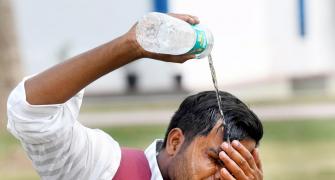The United Progressive Alliance government is all set to pass the historic National Rural Employment Guarantee Bill 2004.
Here's a primer on all you want to know about the government's rural job guarantee scheme.
The World Bank says that more than 30 per cent of the Indian population lives on less than $1 (Rs 43.50) a day, but Indian economists believe the figure of poor -- especially rural poor -- could be much higher.
We have tried to fight poverty by various means, but have met with little success. So what India needs is something more lasting than patchwork policies to help its millions of poverty stricken people.
The government feels that the National Rural Employment Guarantee Act can solve that problem, given that it has the potential to provide a livelihood of millions. But will the plan succeed? Why is there resistance to it? What will it cost the nation? Read on. . .
What does the Bill promise?
The National Rural Employment Guarantee Bill, 2004 promises wage employment to every rural household, in which adult members volunteer to do unskilled manual work. Through this Bill the government, aims at removing poverty by assuring at least 100 days' employment.
The word 'poor household' was replaced by 'household' for guaranteeing jobs in every household for one person.
The original Bill had laid down that it would be applicable only to families living Below the Poverty Line.
Jobs for rural poor: Will the plan work?
Who will run the show?
State governments, Panchayati Raj institutions as well as non-government organisations would be involved in implementing the law.
Who is the chief designer of the scheme?
Jean Dreze, a Belgian economist, who is currently with the Delhi School of Economics, is the chief author of the scheme.
What is the minimum wage promised?
The minimum daily wage had been pegged at Rs 60.
How much has been allotted for this purpose?
The United Progressive Alliance government in the Budget for 2005-06 had raised the allocation for the Rural Development Ministry to Rs 24,000 crore (Rs 240 billion).
How much will it cost India annually?
The National Rural Employment Guarantee Act will cost about Rs 40,000 (Rs 400 billion) crore annually.
According to another estimate, however, it could cost about Rs 50,000 crore (Rs 500 billion) annually, or about slightly less than 2 per cent of GDP.
Where will the money come from?
The rural development ministry currently is allocated Rs 24,000 crore (Rs 240 billion) annually for all its schemes. To meet the total cost of the ambitious scheme, states will still have to shell out Rs 4,000 crore (Rs 40 billion). The rest of the Rs 12,000 crore {(Rs 120 billion) assuming the total cost works out to Rs 40,000 crore} might be raised from other schemes whose allocations may now be merged into this project.
Finance Minister P Chidambaram says that the government will meet the requirement for the job guarantee scheme by:
-
Normal increase in budgetary support;
-
Savings from existing employment schemes; and
-
Additional allocation in gross budgetary support to states.
Chidambaram said the states' share in the funding is only 10 per cent. In his Budget for 2005-06, Chidambaram had stated that the National Food for Work Programme would be converted into the National Rural Employment Guarantee Scheme with an allocation of Rs 11,000 crore.
Where will it be first implemented?
To begin with, as many as 200 districts, including 150 districts under the Food for Work Programme, would be covered under the Bill. It would be extended to all the 600 districts in the country within five years.
The Bill also provides for unemployment allowances if the job, under the scheme, is not provided in the rural households.
What is India's rural population?
According to the last Census, 72 crore (720 million) people lived in rural areas.
What is the unemployment rate in India?
Currently it is said to be around 7.8 per cent, unemployment has been rising in India. This has led to a migration of huge numbers of people from rural to urban areas.
With over 65 per cent of India's population under the age of 35, the country needs to create 6 crore (60 million) jobs over the next five years to prevent the unemployment rate from gaining unmanageable proportions.
What are the demerits of the Bill?
-
The decision to provide Rs 60 per day for a guaranteed 100 days rural employment translated to only Rs 500 a month, which is not sufficient to run a family.
-
The law could lead to friction within a family over selection of the member to be provided the job.
-
It is feared that in the process women and physically challenged could be left out.
-
The decision to make the state governments finance 10 per cent of the scheme could lead to financial problems because of the poor financial conditions of some states.
Why is there more resistance to the scheme?
Many people feel that the huge cost of the scheme might not be affordable for the country. Some analysts say that this could lead to a sharp rise in interest rates and the nation's fiscal deficit.
Other critics of the scheme say that this will spawn, nay encourage, corruption.







